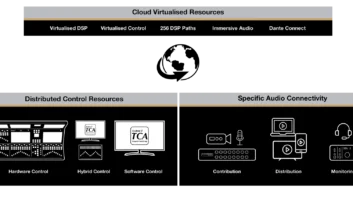
Over the last few years, the cloud has become the de facto way of storing, retrieving and working with applications and data. Within the broadcast sector, innovative individuals are busily improving collaboration and reducing production time by exploiting a range of applications in the cloud, from Dropbox to highly sophisticated video production systems.
However, the ease with which these subscription based applications can be purchased and deployed has resulted in some within IT raising concerns regarding lack of central control and technology fragmentation. But is this really the case?
Aframe’s David Peto dismisses the myth of cloud chaos and outlines how businesses are harnessing the power of cloud video without compromising IT control.
Cloud anarchy
The speed with which cloud based applications are beginning to pervade businesses of every size has taken some organisations by surprise not least in IT where the ease of deployment and the ability to rapidly exploit innovative applications to meet specific business requirements is a world away from the traditional, extended, on premise deployment model.
Forward thinking individuals across the business are now actively seeking solutions to address specific problems; exploiting free trials to assess the features and functionality; and using the SaaS, subscription based model to negotiate directly with vendors.
These cloud based applications are hugely compelling in ensuring any organisation is using technology that truly meets business needs. The user led approach does, however, potentially raise concerns for an IT team that has no knowledge of the different systems that have been adopted or the value of the contracts agreed.
How should the CTO react after discovering that one department is uploading video or highly confidential scripts to consumer style cloud solutions such as Dropbox, while another is using a dedicated cloud based video production system? Or that global contributors are being encouraged to share footage via the cloud?
Take control
It is clearly a concern for any CTO to suddenly discover that multiple cloud based solutions or multiple instances of the same solution have been adopted by different departments. While each department is gaining benefits, reducing the cost of production, improving timeliness of edits or gaining faster access to global news stories, there is a clear business risk associated with excluding IT from the decision making process.
Ensuring IT has oversight of the technology adoption across the organisation is essential to realising the full benefits of these innovative solutions. For example, if departments are negotiating separate contracts with the same supplier, economies of scale are likely to be missed and IT can play a key role in negotiating a far more cost effective enterprise level deal. Furthermore, if IT has both oversight and understanding of the benefits being attained by each department, it becomes far easier to identify other business areas that may benefit such as the development of a global news portal to transform the speed and effectiveness of news gathering.
It is also a model far preferred by the technology vendors because it provides a single point of contact and discussion for on-going product development and enhancement that can be extremely valuable to both parties. An IT department that has access to all user and departmental feedback about ROI can give a vendor far better insight into on-going product developments that reflect broad, rather than department or genre specific, requirements.
Right approach
Given that most broadcasters will already have pockets of cloud deployment across the organisation, what is the best way forward for the CTO? Users have actively sought out and embraced these solutions for a reason and are gaining quantifiable value from the technology. Simply banning all access is not only going to be an unpopular move, it is likely to impact essential business processes.
The alternative is to take a proactive approach and sanction one cloud based video production solution. Offering it to the organisation, with no particular recommendation or forced adoption, and asking for feedback, transforms the entire model. Users perceive the solution to be self-selected because it has not been imposed, while IT has the benefit of central control and visibility, as well as the financial value of a single contract negotiation and a structured agreement.
In addition to achieving financial and corporate control, by avoiding the adoption of multiple cloud solutions the business minimises the risk of data fragmentation. And this is key. One of the fundamental requirements for any broadcaster is to enable effective, secure sharing of data. From sports and news departments sharing footage of a report about Michael Schumacher, to libraries of expensive background shots and the multiple groups that need access to drama productions including post production, compliance, marketing, promotions, even other broadcasters in different jurisdictions providing a single location for all production footage is an essential component of effective cloud utilisation. A fragmented adoption of cloud technologies fundamentally undermines that model and radically reduces the corporate ROI.
Conclusion
Cloud chaos sounds threatening but, with the right attitude, it is also a myth. Despite the hype about cloud technologies and the proliferation of true cloud based solutions, broadcaster adoption is still in its infancy. But timing is key: users are showing initiative they are actively seeking out technologies in the cloud that are delivering value and improving day to day operations. And with the speed of deployment that underpins the cloud model, it is essential to take control today and exploit unprecedented user commitment to innovation and technology change. There is no need to throw out every instance of ‘unauthorised’ cloud deployment that misses the point and undermines user confidence in IT. Nor is this a model where forced adoption will work. Instead, encouraging users to test out and play with specific cloud technologies and, critically, provide feedback on their viability and value, enables the business to exploit innovation without any risk of cloud chaos.
By marrying the innovation enabled by a user led technology adoption model with centralised IT procurement, the CTO can take control while releasing the business to actively explore and exploit valuable technologies that deliver measurable value.







